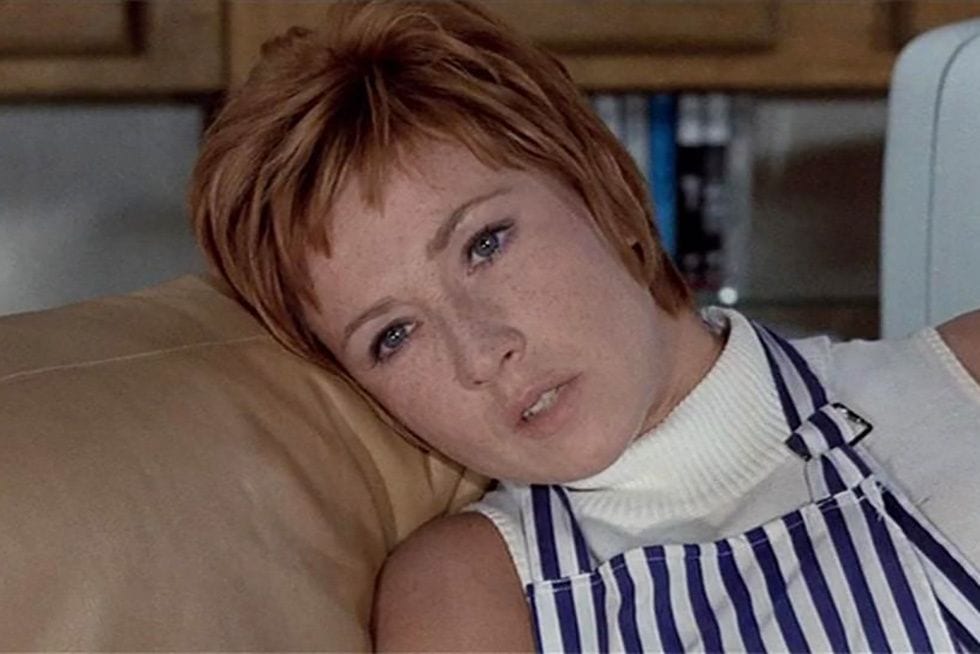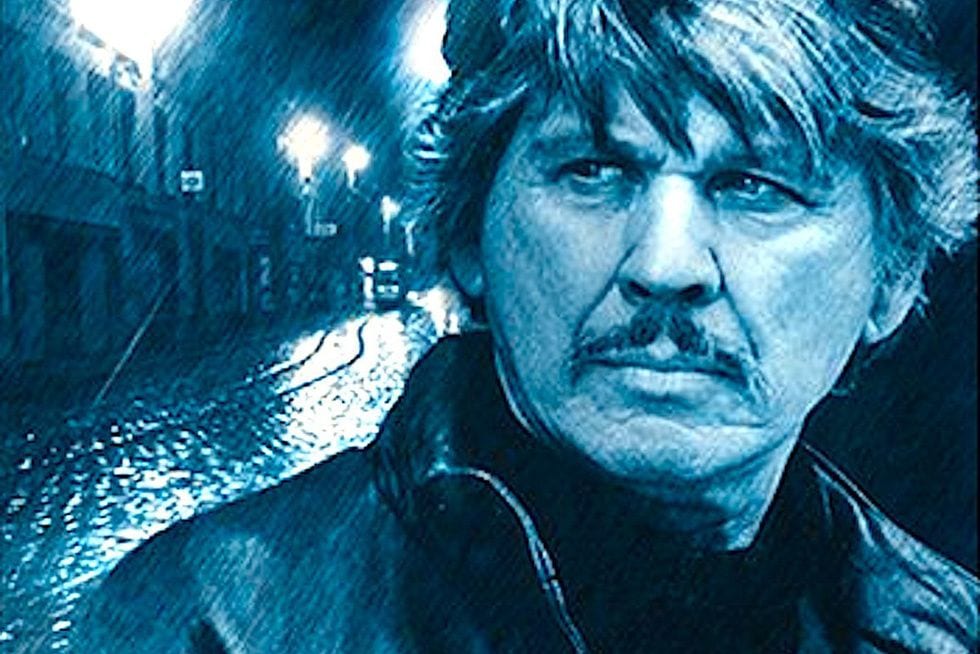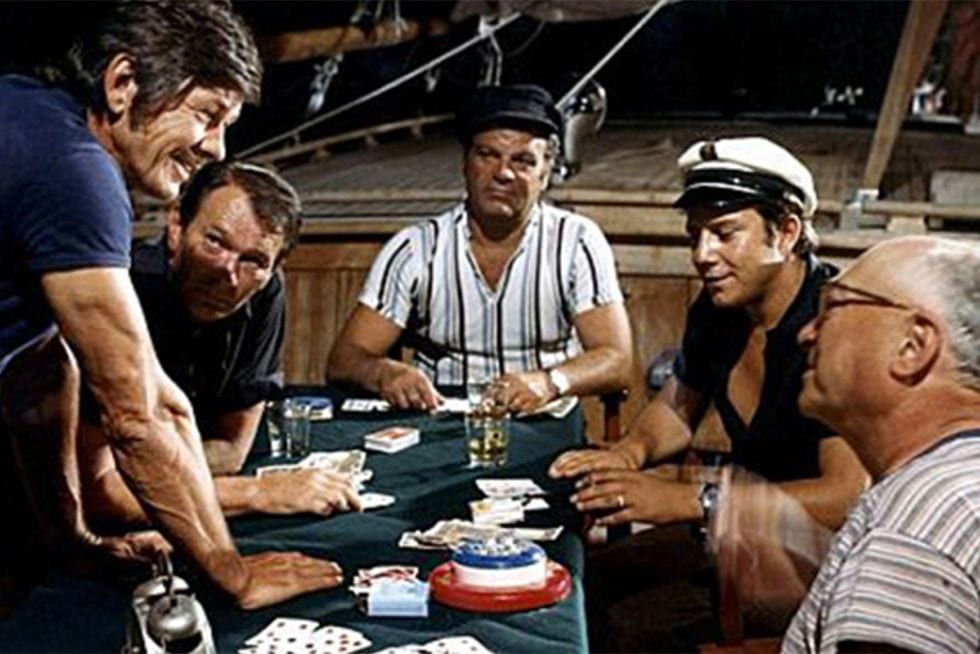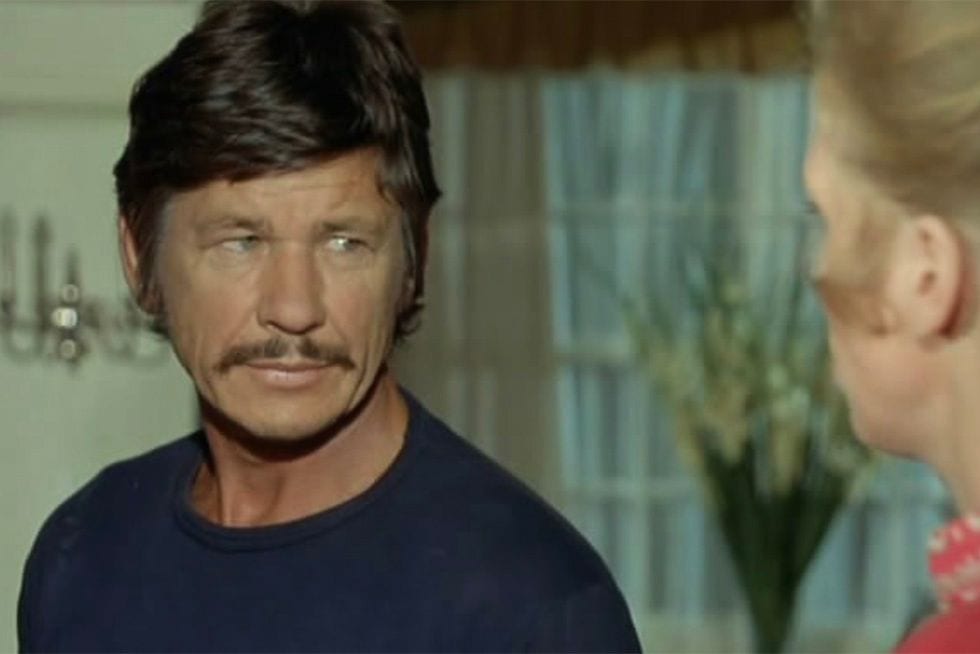

Now released on Blu-ray from Kino Lorber are two Charles Bronson movies from 1970, looking better than they have in pretty much forever. Rider on the Rain and Cold Sweat, which both cast Jill Ireland (Bronson’s wife) in supporting roles, belong to a Golden Age of internationally co-produced Euro-thrillers of the late ’60s and early ’70s that combine pulp storytelling with stylistic elegance and intense emotion, and which were largely dismissed as trash by contemporary critics. As “trash”, however, they proved sophisticated enough that we could use more of their like today.
Rider on the Rain (Le Passager de la pluie)
Rider on the Rain kicked off a final string of four terrific thrillers from director René Clément. This excellent craftsman is best known, at least in the US, for the humanist war film Forbidden Games (1952) and for one of actor Alain Delon’s two early breakthroughs, Purple Noon (1960), the first film version of Patricia Highsmith’s novel The Talented Mr. Ripley (1955).
In the ’60s, Clément turned to co-productions that threw together stars of various nationalities and aimed mainly at the English-language market, such as the superb cat-and-mouse thriller Joy House (1964) with Delon, Jane Fonda and Lola Albright. That one needs a Blu-ray, and so do the films that followed Rider on the Rain: The Deadly Trap (1971) with Faye Dunaway and Frank Langella, And Hope to Die (1972) with Jean-Louis Trintignant and Robert Ryan, and Wanted: Babysitter (1975) with Maria Schneider. But before we get too far afield, let’s concentrate on his Bronson picture.
Rider on the Rain headlines Bronson, yet it’s not really his character’s story. The audience’s point of view aligns with its heroine, Mellie Mau (Marlène Jobert). In a beautifully timed revelation, we learn that her name is really Mélancolie, and it fits. She’s not only sad but frightened and childlike or doll-like, which is one reason the film opens with an epigraph from Lewis Carroll’s Alice in Wonderland, the passage in which Alice falls so slowly down the rabbit hole that she has plenty of time to look about her.
Mellie’s personality has something to do with being raised by a bitter mother (Annie Cordy) who runs a bowling alley and tells her all men are pigs or bastards (depending on which language she’s speaking), and whose husband split because of her infidelity when Mellie was a child. Mom has a point. As Mellie navigates the world, literally every man she meets or knows is some kind of threatening bully who patronizes or infantilizes her or worse. That includes her handsome Italian husband Tony (Gabriele Tinti), an airline navigator who’s full of Old World prejudices inherited from his father.
We don’t know any of this at the beginning. We pick it up as we travel deeper into Mélancolie and she gradually finds the strength to confront the men around her and to face her fears. To a great extent, this film expresses her journey through a frightening wonderland into a new maturity, which includes recognition and rapprochement from her mother. That maternal relationship is reminiscent of the one in Alfred Hitchcock’s Marnie (1964), only much better. One street name is the Avenue de l’Arrogante; everyone in the film is arrogant, and Mellie will finally learn to stop pretending and come into her own mastery so that she can stop relating to others through lies.

The film opens with Mélancolie’s world, where it’s raining while Francis Lai’s understated, melancholy music scores the beautiful image of drops hitting the wet road as a bus passes in the lowering gloom. One difference between the English and slightly longer French version of this film, which are both on this disc, is that the color grading on the English is greener and gloomier here, while the French beginning feels vibrant in a way that seems tonally off. Andréas Winding’s photography feels more poetic and beautiful in the English version.
Dressed in her standard snow white, Mellie looks through the wet window of mom’s bowling alley and notices a tall, bald, wolf-like man (Marc Mazza) get off the bus. He will haunt her through the opening reel like a fairy tale figure; his eventually revealed name, Mac Guffin, is symbolic of his nature as a plot device. When he attacks Mellie in a terrifying and disturbing scene, she’s launched into a painful, paranoid odyssey whose next step is triggered (literally) by her response to his assault. Let’s use the “R” word: he’s a rapist.
The horrific nature of the sequence, including its stunning catharsis, lingers like a miasma or fever as Mellie pushes forward into her strange new world and discovers untapped resources within herself. The film makes the point that her efforts are never easy but may be necessary, for if these traumatic events had never happened, she’d have remained trapped in the bourgeois helplessness into which she’d voluntarily retreated and suffocated slowly, like her mother.
Soon thereafter Bronson enters the picture as the enigmatic Dobbs, another almost supernatural figure of menace and mercurial emotion. He calls himself a hunter while she calls him the Cheshire Cat. His first line: “Why did you kill him?” He’s an almost demonic force of power, knowledge and manipulation who hijacks Mellie’s life, demanding a McGuffin whose form and meaning keeps shifting. There’s much talismanic business between them of picking up and transferring coins, buttons and even walnuts that have some numinous meaning beyond their plot mechanics.
Dobbs functions as a mysterious doppelgänger of both Mellie’s attacker and her husband. Is he more one than the other? He’s a dominating presence whose motives feel unreadable and whose methods are rightly questioned by his associates, and these qualities connect to a subtext of his status as an authoritarian American in Europe. If we want to push the national allegories, then he’s America, she’s France, the husband is Italy, the house is NATO, and the McGuffin is what they’re all afraid of, but that’s a less satisfying reading.
Dobbs, who shares a name with Humphrey Bogart’s ruffian hero in John Huston’s The African Queen (1951), goes on the film’s secondary journey as he confronts the results of his own bulldozer tactics and finally admits out loud that he made a mistake. The ending implies that he may have made more than one.

Before the rupture introduced in the first reel, Mellie’s status quo involved pleasing her husband as a Victorian child-wife. As they lounge or prance in silk pajamas after sex, he hands her money in accordance with the request she wrote on her mirror (narcissism) in lipstick (feminine appeal): “I’m flat broke” (in the French version: “Je n’ai plus de SOUS“). This is how they communicate and negotiate, and of course the looking-glass is one of Alice’s vehicles. Later, our heroine identifies with a figurative double (Ellen Bahl) and tracks down the woman’s home, only to realize it’s a bright red brothel run by a kind of Red Queen (Corinne Marchand).
This fascinating, labyrinthine film pulls off the rare trick of maintaining its heroine’s POV for the first 90-minutes. We see, hear and know only what Mellie sees, hears and knows, and we feel as she feels. Our identification with her situation is total, and it’s why the film is so disorienting, sometimes perverse. We not only observe what she does and listen to how she lies, but we even seem able to watch her thinking. She claims to be good at math so she can figure things out, and one of the film’s narrative pleasures is watching her prove it even amid her stumbles and false starts.
She’s definitely in over her head, yet she plunges through by instinct and calculation as the script throws new curves at her. She learns to come forward into the world, best symbolized by Paris and the dizzying Eiffel Tower, rather than hide from it. If the initiating event feels brutal to viewers (as it is), the movie adopts a harsh French attitude that there’s no liberation or self-discovery without pain. That’s not only true for the heroine. When she briefly, accidentally points a shotgun barrel into the camera, the locus of a presumably male gaze, it’s more than Clément’s idle gesture.
Although Mellie’s no virgin, her all-white fashions suggest a form of innocence that’s been doing her no good. The same is true of her habit of avoiding “bad words”. Noticing a change in Mellie, her mother reflects that it’s about time, and she’s speaking for the movie’s function as a parable of the era’s rising feminist consciousness. The diminutive girl’s adult “Mélancolie” can finally be recognized, as her true name now becomes her.

The strict adherence to Mellie’s POV extends even to a crucial shot observing her from inside the cellar, which is handled with a clearer delineation of her trespasser in the French version. This is probably the most significant difference between the two versions, besides the color palette.
Ireland plays her fashionable friend who runs a clothing boutique, where identities are exposed or disguised, and there’s a cameo by Marika Green, Jobert’s sister-in-law, who starred in Robert Bresson’s Pickpocket (1959).
The writer responsible is Sébastien Japrisot, France’s leading practitioner of misdirectional triple-reverse thrillers. His novels are often woman-centered and have been adapted into such films as Anatole Litvak’s The Lady in the Car with Glasses and a Gun (1967), with Samantha Eggar and Oliver Reed (and long MIA on video), and Jean-Pierre Jeunet’s A Very Long Engagement (2004) with Audrey Tautou. Rider on the Rain is an original story, exquisitely paced and modulated by Clément as a vehicle for Jobert, and it received some recognition, including a Golden Globe for Best Foreign Film.
The English version is to be preferred both for its visual tone and Bronson’s voice. Although Wikipedia’s entry on this film claims he learned French phonetically, it’s clear he’s dubbed in the French version. He’s even dubbed during the brief scene where he speaks English.
Since Bronson plays a threatening and unsympathetic character for most of the film (and very well), this may disappoint fans looking for more standard hard-hitting Bronson fare. Or then again, maybe it won’t. This is one of several films in his European period demonstrating his versatility.
Cold Sweat (De la part des copains)
Four years before Bronson’s biggest breakthrough as a tough action hero in Michael Winner’s Death Wish (1974), Cold Sweat already finds him as a relentless character trying to protect his wife and daughter from the fates that awaited them in that later film, so that it comes across as almost a dry run, but more intelligent, humane and European while still delivering plenty of violence and thrills.
In a town on the French Riviera (shot in Beaulieu-sur-Mer), Joe Martin (Bronson) makes a living chartering his boat and lives with his wife Fabienne (Liv Ullmann). Their marriage is marred by a mutual touchiness connected to his hidden past, something she doesn’t suspect while he suffers nightmares and alcoholic cravings. She complains that she gets lonely when he’s out all day but his gruff animal attraction makes it up to her, especially in the skin-tight black shirt and blue pants he’ll wear through the whole picture, his veiny arms bulging like Popeye‘s.
A rapidly accelerating 24-hour nightmare begins in time for Bastille Day, ironically enough, as getting out of prison proves a crucial kick-off to the story. When some get out of prison, others are imprisoned in turn, or rather the nature of their long-term existential prison is finally exposed.
The suspense begins as a home-invasion thriller in which Joe and Fabienne are held hostage by men who turn out to be Joe’s old army comrades. They were left to rot in prison when Joe, their driver, cut out on them in response to a killing. The first to arrive at Joe’s house is a precursor or harbinger of the rest, like a sinister John the Baptist, establishing the plot’s motif of continually fooling us into thinking resourceful Joe gets the upper hand and is about to wrap things up, but there’s always one more twist. The story frequently sets us up for one kind of development only to shift gears into something else amid lots of complicated back and forth and changing alliances. We’re faked out more than once.

James Mason gives a peculiarly accented performance as the brains of the group, while stooges played by Luigi Pistilli, Michel Constantin and Jean Topart (who sounds as though Mason is dubbing him) are all hotheads. Ireland shows up as the leader’s moll, a spoiled rich girl who craves excitement and stashes marijuana joints in her guitar.
The long, thrilling setpiece that functions as the movie’s big attraction is a car chase, and what a chase. Stunt driver Remy Julienne receives and deserves his own major credit for the breathless sequence that not only involves POV shots speeding around the mountainous curves amid near-miss traffic but a protracted cross-country stunt so ballsy and ridiculous that it’s funny as well as exciting. It’s also inspiring to realize that they’re really doing it, not disguising things through excessive editing or CGI. Apparently there’s more than one way to get around a mountain. The tightly edited clarity combines with abstraction as the red car flares into a shimmering double of itself during the most delirious shots.
Car chases are the time-wasting bane of many a pseudo-action movie, but occasionally you get one that’s truly inventive, seamless and nerve-wracking, and this movie sells the heck out of it. One of the bonus trailers for this film is simply a lengthy sample of this sequence. European chases often have a dangerous quality that you hardly find in Hollywood ones, unless filmed in San Francisco.
The source for the story is Richard Matheson’s novel Ride the Nightmare (1959), previously filmed under that title as a 1962 episode of The Alfred Hitchcock Hour starring Hugh O’Brian and Gena Rowlands. Scripted by Matheson, that version more closely follows his exposure of suburban America as nightmare and his recurring theme of the male provider whose ability to protect his family is undermined by paranoia, insecurity and chaos. At his best, as in I Am Legend (1954) and The Shrinking Man (1956), Matheson was a master of male suburban panic.
This film dilutes that message somewhat because, from the beginning, Bronson doesn’t take any guff and continually proves equal to the situation. His wife, after initially arguing and freaking out, will also rise to the occasion and prove her determination to save her family, especially during a sequence involving a fire. The American roots of the story have been uprooted for European purposes as the film becomes a thrill machine that makes full use of its Mediterranean locale.

British director Terence Young, most famous for the first three James Bond films, devoted much of his career to international co-productions like this one, the first of his three Bronson items in quick succession. Cold Sweat allows him to balance his muscular outdoorsy facility with the intimate stage-bound approach he exploited in the classic Wait Until Dark (1967). In both modes, he’s abetted by Claude Chabrol’s regular cinematographer, Jean Rabier, who emphasizes smoothness and clarity.
While the belated American release called the film Cold Sweat, this lovely print opens with the French credits, which call the film De la part des copains (roughly “from friends” or “on behalf of friends”). The English-language credits that say Cold Sweat can be found on Youtube. They differ interestingly on the screenplay. Both list prominent American TV writer Shimon Wincelberg, while the French version adds French crime writer Albert Simonin, plus a dialogue credit. The US credits list Wincelberg plus Dorothea Bennett (Young’s wife) and veteran American noir writer Jo Eisenberg, who most famously worked on Charles Vidor’s Gilda (1946) and Jules Dassin’s Night and the City (1950).
Producer Robert Dorfmann, who also produced several of Clément’s films, was a major force behind the era’s Euro-thrillers and was having a banner year. Besides Cold Sweat, IMDB credits him in 1970 with producing Costa-Gavras’ The Confession with Yves Montand and Simone Signoret, Jean-Pierre Melville’s Le Cercle Rouge with Delon, Luis Buñuel’s Tristana with Catherine Deneuve, and least famous of the batch, Georges Lautner’s The Road to Salina, another “Euro-pudding” thriller with American stars, in this case Mimsy Farmer and Robert Walker Jr.
Both Blu-rays offer the same lively trio of historians on the commentary track: Howard S. Berger, Steve Mitchell and Nathaniel Thompson. The discussion of Rider on the Rain emphasizes Clément’s themes, including children and maturation, and this stage of Bronson’s career. They compare his character to Highsmith’s Ripley and link Jobert’s character to Audrey Hepburn’s in Wait Until Dark. For Cold Sweat, they discuss Young’s style and swoon over references to Anthony Mann westerns. In general, Thompson brings the research while Berger adopts a free-associational style that comes perilously close to rattling on–an approach redeemed when you know what you’re talking about, as he does. (That is, I tend to agree with him.)
No doubt Bronson’s continuing star power determined these two releases, and we hope that will extend to his 1971 Euro-pudding thriller, Nicholas Gessner’s Someone Behind the Door with Ireland and Anthony Perkins. In fact, there’s a rich vein of the era’s thrillers to be re-evaluated. Many of the era’s American reviewers saw them in inferior prints and got annoyed by the mix-and-match of dubbing and original actors’ voices. When seen in their best light, these films often deliver the goods while remaining more thoughtful and clever than their reputations suggest.


![Call for Papers: All Things Reconsidered [MUSIC] May-August 2024](https://www.popmatters.com/wp-content/uploads/2024/04/all-things-reconsidered-call-music-may-2024-720x380.jpg)



